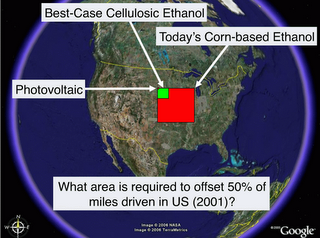Tesla Motors and Batteries
 The more I read of Tesla Motors, the more I like them. I completely agree with their vision of the future and I believe their business plan will make it happen. These guys "get it". Check out their blog if you haven't. I am amazed at the number of comments that people leave.
The more I read of Tesla Motors, the more I like them. I completely agree with their vision of the future and I believe their business plan will make it happen. These guys "get it". Check out their blog if you haven't. I am amazed at the number of comments that people leave.
This slide show comparing battery cars to hydrogen fuel cells, ethanol and biodiesel is great. If I were to bet on a technology long term for automobiles, I would take battery powered cars over biofuels and hydrogen fuel cells. The image on how much land is needed to offset 50% of the miles driven in the US sums it up perfectly for me.
For electric battery cars to become common place they still need to overcome the 3 R's: range, recharge time and retail price. If the range of the car is far enough, the recharge time quick enough and the retail price low enough, electric battery cars will overtake internal combustion cars as they are much more efficient with the energy they use.
This relies on having better batteries. How quickly is this happening? From the Tesla blog:
But the capacity of batteries – particularly lithium ion type batteries – has increased steadily by about 8% per year for the last couple of decades. All indications are that this will continue into the future, doubling in capacity every ten years. (And there are hints of breakthrough technologies that might speed things up for us.)From a talk given by Tesla's CTO reported by The Digital Crusader:
He presented a chart with year along the X axis and Wh/litre (energy density) along the Y, with curves for NiCD, NiMH and Li-ion batteries. The Li-ion batteries have tripled their density (from 200 to 600) since about 1990, and are on track for more - and Li-ion are themselves better than the older technologies: it's these facts which have made the difference between the EV1 in the early 90s and the Tesla Roadster now. In addition, the battery price is falling steadily as well, he claimed about 2% per year.A doubling of capacity every 10 years and a 2% decrease in price a year. Not quite Moore's Law, but at least they are making progress.





No comments:
Post a Comment
Note: Only a member of this blog may post a comment.